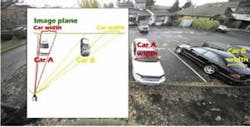Video Expert: Image Resolution and the Power of the Lens
For those in the security industry, we know that the detail in an image is determined by resolution and that the term “resolution” has many definitions including the number of pixels of the image sensor used to record or reproduce an image and the number of pixels per foot or meter at the object. This latter definition of mapping of the image sensor dimensions onto the object is most intuitive for calculating what level of detail can be seen in the image. Generally, it is the horizontal field of view (HFOV) of the camera divided by the horizontal number of pixels. This gives a pixels-per-foot number that can be related to image quality.
There is not yet an industry standard for the level of sharpness required in every video surveillance application. The more pixels on a target, the higher the image resolution (resolution = pixels/ft.) will be and the more likely recognition and positive identification will be made. However, higher detail requires higher resolution cameras (resolution = total pixels) or more cameras and thus more bandwidth and storage. There is a balance that must be made between level of detail and project budget.
A clear advantage of the higher pixel count available from megapixel cameras is the ability to cover a much wider area with the same or better image resolution compared to analog cameras. The wider the field of view required, the shorter the lens focal length that is needed. Greater than about 90 degrees, most lenses start to show curved, barrel distorted images that compress the image at the edges. Rectilinear lenses don’t exhibit barrel distortion and thus maintain image resolution out to the edge of the image.
Rectilinear vs. fisheye lenses
Most wide angle lenses have barrel distortion (also known as fisheye distortion) that causes the image to look curved and bulged out in the center. Rectilinear lenses keep lines that appear straight in the real world the same on the image sensor. This has the benefit of increasing the resolution of the image at the edges.
A typical lens greater than a 90-degree field of view will have barrel distortion that causes the image to be compressed at the edges and resolution is reduced. With this type of distorted wide angle lenses, potentially valuable information is lost in the lens and no software, de-warping or otherwise, can recapture or reconstruct this lost information in the image.
With a rectilinear lens, objects in a common plane perpendicular to the camera have the same image resolution at the center and edge even though the objects at the edges are much farther away from the camera, as shown in the first image here.
This creates an effect called 3D stretching or lean-over in which objects at the image edge seem to be stretched because they are being “flattened” onto a plane along the tangent angle from the lens. With rectilinear lenses, the wider the field of view, the more noticeable this effect. This effect has the advantage of increasing image resolution for objects at the edge of the image compared to lenses with barrel distortion. For lenses with barrel distortion, the objects at the edge of the image will be smaller than those in the center and they will curve towards the center.
In defining what type of lens is needed for your surveillance needs, remember that resolution is defined as both the total number of pixels in a camera and the pixels per foot in an image.
Mark Peterson is vice president of Advanced Technology for Theia Technologies, Wilsonville, Ore. He can be reached at [email protected].
About the Author
Mark Peterson
vice president of Advanced Technology, Theia Technologies
Mark Peterson is vice president of Advanced Technology, Theia Technologies, Wilsonville, Ore.
